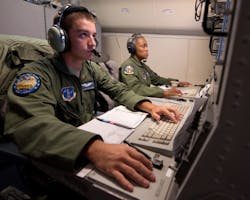KBR Centauri to develop synthetic aperture radar detection algorithms to image ground moving targets
WRIGHT-PATTERSON AFB, Ohio – U.S. military researchers needed algorithms and collection techniques to enable synthetic aperture radar (SAR) sensors to detect, geolocate, and image moving targets on the ground . They found their solution from the KBR Inc. Centauri segment in Chantilly, Va.
Officials of the U.S. Air Force Research Laboratory at Wright-Patterson Air Force Base, Ohio, announced an $11.1 million contract to KBR Centauri on Monday for the Moving Target Recognition (MTR) project.
MTR revolves around recognizing slow-moving military vehicle targets with synthetic aperture radar (SAR) signatures that are superimposed on clutter. The Air Force awarded the contract on behalf of the U.S. Defense Advanced Research Projects Agency (DARPA) in Arlington, Va.
MTR will include airborne data collection experiments to test and evaluate algorithms to detect moving ground targets. KBR Centauri experts will be responsible for the airborne radar sensors and flight services, while DARPA will handle designing experiments that involve moving ground vehicles, instrumented to provide ground truth.
If the project succeeds at moving target detection, geolocation, and imaging, MTR will start developing ATR algorithms for moving target images.
The MTR program is part of the DARPA Mosaic Warfare vision, which seeks to create rapidly reconfigurable military forces that are fast, unpredictable, flexible, and adaptable -- more like the pieces in a mosaic piece of art, rather than a collection of rigidly designed pieces of a puzzle.
The MTR program has two phases: a two-year effort that focuses on locating moving targets, as well as detection and imaging; and automatic target recognition (ATR) of the moving target images. Several contract awards are expected.
On this contract KBR Centauri will do the work in Ann Arbor, Mich., and Navarre, Fla., and should be finished by January 2024. For more information contact KBR Centauri online at www.kbr.com/en/centauri, the Air Force Research Laboratory at www.afrl.af.mil, or DARPA at https://www.darpa.mil.

John Keller | Editor-in-Chief
John Keller is the Editor-in-Chief, Military & Aerospace Electronics Magazine--provides extensive coverage and analysis of enabling electronics and optoelectronic technologies in military, space and commercial aviation applications. John has been a member of the Military & Aerospace Electronics staff since 1989 and chief editor since 1995.

